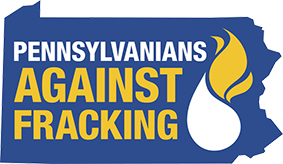Pennsylvania’s Failure to Produce Clean Power: Global Warming from Natural Gas
Pennsylvanians Against Fracking Position Statement
This is the fourth in a series of statements on the Clean Power Plan presented by Pennsylvanians Against Fracking. In our last statement on the Plan, we discussed that a rash of new natural gas power plants have been approved by Pennsylvania Department of Environmental Protection since 2014, revealing the state’s planned energy path of dirty shale gas instead of clean renewable choices. This paper examines the greenhouse gas emissions and global warming effects of this new natural gas power plant scheme.
If Pennsylvania employs a dirty gas energy path that uses the “natural gas loophole” by excluding recently-approved natural gas power plants (39 new plants, and 3 expansions) in its compliance plan for the U.S. E.P.A’s Clean Power Plan, then dozens of gas power plants approved by the state since 2014 may be omitted in the determination of emissions and go on to warm the climate without regulation.
The EPA’s Clean Power Plan targets a 32% reduction nationally from 2005 levels of carbon dioxide ( CO2) stack emissions from power plants by 2030, or roughly a 15-16% reduction relative to 2012 levels (US Dept. State, 2014). The EPA plan uses three “building blocks” to calculate state CO2 emission reduction goals: 1. Building or retrofitting “clean coal” plants; 2. Increasing the usage rate (“capacity factor”) of existing natural gas power plants using combined cycle technology; 3. Meeting power generation capacity with renewable energy without fossil fuels. The EPA also suggests that efficiency can play a central role in meeting targets. The EPA goal set for Pennsylvania is a 23% reduction in CO2 stack emissions from the power sector, relative to 2012 levels, by 2030.
Until Pennsylvania submits its state implementation plan to meet the federal carbon emissions reduction goal, it is impossible to know exactly what the power mix will look like in 2030. States use Independent Integrated Planning Model (IPM) assessments to develop how they will meet carbon reduction goals.
However, IPM forecasts reflect changes in stack CO2 emissions only. Emissions sourced “upstream” of the emission stacks are not included. Upstream emissions include those associated with the manufacture of materials for the construction of new power plants and/or fuel source infrastructure, as well as fugitive and combustion emissions associated with extraction, processing, and transport of the fuel source. Upstream emissions make up roughly half the total lifecycle emissions (upstream + stack emissions) and can quickly erode any climate benefits achieved in reducing stack emissions.
In Pennsylvania, IPM model results also do not account for 11.3 gigawatts (GW) of the 16.4 GW of new natural gas power plant builds, extensions, and fuel conversions recently permitted by PADEP. This plethora of new permits indicates the state is choosing to substantially increase natural gas fired power, the results of which will be catastrophic for Pennsylvania’s environment, causing the state to fail to meet climate goals, and undermining global climate warming limits for the United States and those set by COP21 in Paris. Natural gas consumption in the state’s power sector will increase by an estimated 72% by 2030. Stack CO2 emissions will miss the required 23% federal emission reduction goal for the state by 4.5%, achieving only an 18.5% reduction. Life cycle emissions from these natural gas power plants will be even worse. If we apply the federal stack emissions reduction goal to life cycle emissions, Pennsylvania will fail to meet net emissions reduction for the State’s power sector by 15%, achieving only an 8% reduction. Once online, the additional projects will have an annual lifecycle carbon dioxide equivalents (CO2e) emissions burden of 126.6 million metric tonnes (MMt) by 2030, which will be more than half the 2012 total lifecycle emissions from the state’s power sector (231.5 MMt CO2e), even after factoring in a reasonably achievable 62% reduction in coal consumption. This failure substantially contributes our nation’s climate crisis and would be a terrible legacy for the Commonwealth.
Pennsylvania must choose Option 3, renewable energy sources and energy efficiency measures to meet power generation with no new fossil fuel plants if the goal is to really reduce greenhouse gas emissions and curb climate change. The flexibility provided in the federal Clean Power Plan supports a powerful clean renewable energy path that provides long term energy stability that does not damage the environment and worsen global warming. This clean energy path is not only worth doing but absolutely necessary if we want to begin to address climate change at the state level. And of course it provides environmental and human health benefits that are urgently needed to protect Pennsylvania’s water, air, and communities by avoiding the extraction and natural gas development/infrastructure impacts that the natural gas power plant options would institutionalize.
PSE Healthy Energy conducted this technical analysis for the Delaware Riverkeeper Network.
Find all of PAF’s CPP statements





